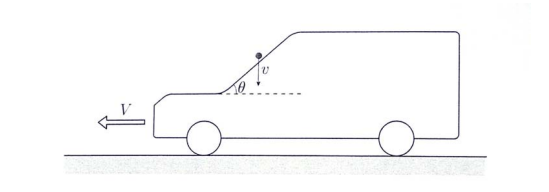#Problem# ###Definition### As shown in the figure below, an automobile is travelling horizontally in the rain with a constant velocity V. The windshield has a slope of θ. A raindrop with a mass of m, falling vertically with velocity v hits the windshield. Force is applied only perpendicularly to the windshield and the raindrop starts sliding on its surface. Any effect caused by air is ignored.

###Question### What is the minimum ratio of V/v so that the raindrop starts sliding upwards? Provided possible answers are: sinθ; cosθ; tanθ; 1/sinθ; 1/cosθ; 1/tanθ.
EDIT: Below is my view on how I thought things were supposed to happen, but that doesn't take into account the fact that air resistance (i.e. wind) is ignored by definition
If I have to be honest, I really have no idea what I'm supposed to do here. The way I see this, the raindrop moving upwards can only be caused by air resistance. Gravity can be broken down into two vectors, F_w which is parallel to the windshield and F_n which is perpendicular to it. This way F_n is cancelled out by N, which is the normal reaction force. This way, air resistance, which would also be parallel to the ground, would, if the car was moving fast enough, eventually cancel out F_w and the raindrop would start moving upwards.
This however cannot work, since the problem definition clearly states that anything air-related is ignored (which I presume includes air resistance as well). Another thing I can't really understand is the statement "Force is applied only perpendicularly to the windshield" - how is this possible if the raindrop is falling vertically downwards?
I'm not looking for an answer to this specific problem, but rather an explanation of what is going on and how I'm supposed to approach it. I've learned about motion (velocity and acceleration), forces and Newton's laws in school. but none of those seem to work here (or at least not the way I see it). Any help will be most highly appreciated!
